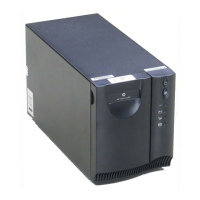UPS operations 30
NOTE: Configure mode times out after 2 minutes of inactivity. If the Test/Alarm Reset button
has not been pressed, any new selections are not saved.
For the location of buttons, see "UPS front panel controls (on page 7)."
For the location of LEDs, see "UPS front panel LED indicators (on page 8)."
Available voltage settings
NOTE: An asterisk (*) indicates the default setting.
UPS model Available settings utility voltage (VAC)
Associated LED ("UPS
front panel LED
indicators" on page 8)
R3000 NA 100 General Alarm
110 On Battery
120* Battery Fault
127 Site Wiring Fault
R3000j JPN 100* General Alarm
110 On Battery
120 Battery Fault
127 Site Wiring Fault
R3000h NA, R3000h JPN 200/208* General Alarm
220 On Battery
230 Battery Fault
240 Site Wiring Fault
R3000 INT 200/208 General Alarm
220 On Battery
230* Battery Fault
240 Site Wiring Fault
Initiating a self-test
To initiate a self-test, press and hold the Test/Alarm Reset button ("UPS front panel controls" on page 7)
for three seconds.
Because a portion of the self-test requires battery power, the self-test cannot be initiated if the batteries are
less than 90 percent charged. If the UPS detects a problem, the appropriate LED ("UPS front panel LED
indicators" on page 8) illuminates and an audible alarm may sound.
For information on what to do if the self-test detects a problem, see "Troubleshooting (on page 41)."
